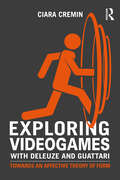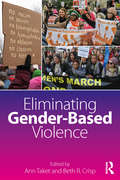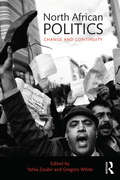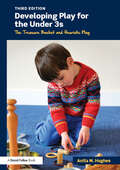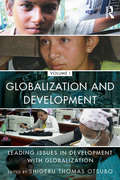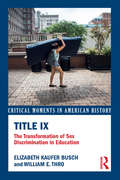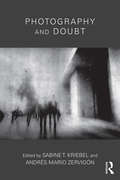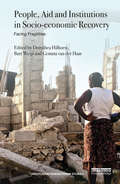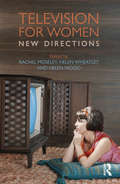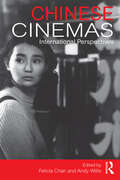- Table View
- List View
Exploring Videogames with Deleuze and Guattari: Towards an affective theory of form
by Colin CreminVideogames are a unique artistic form, and to analyse and understand them an equally unique language is required. Cremin turns to Deleuze and Guattari’s non-representational philosophy to develop a conceptual toolkit for thinking anew about videogames and our relationship to them. Rather than approach videogames through a language suited to other media forms, Cremin invites us to think in terms of a videogame plane and the compositions of developers and players who bring them to life. According to Cremin, we are not simply playing videogames, we are creating them. We exceed our own bodily limitations by assembling forces with the elements they are made up of. The book develops a critical methodology that can explain what every videogame, irrespective of genre or technology, has in common and proceeds on this basis to analyse their differences. Drawing from a wide range of examples spanning the history of the medium, Cremin discerns the qualities inherent to those regarded as classics and what those qualities enable the player to do. Exploring Videogames with Deleuze and Guattari analyses different aspects of the medium, including the social and cultural context in which videogames are played, to develop a nuanced perspective on gendered narratives, caricatures and glorifications of war. It considers the processes and relationships that have given rise to industrial giants, the spiralling costs of making videogames and the pressure this places developers under to produce standard variations of winning formulas. The book invites the reader to embark on a molecular journey through worlds neither ‘virtual’ nor ‘real’ exceeding image, analogy and metaphor. With clear explanations and detailed analysis, Cremin demonstrates the value of a Deleuzian approach to the study of videogames, making it an accessible and valuable resource for students, scholars, developers and enthusiasts.
Eliminating Gender-Based Violence
by Beth R. Crisp Ann TaketWhile promoting access to resources and systems of support for those affected by gender-based violence is absolutely crucial, this new book focuses attention on the important question of how communities can take action to prevent violence and abuse. Using examples of current research and practice, the book explores the actions that can be taken in individual sectors of society, our schools, faith communities, campuses, on our streets and using new popular technologies. The contributors draw on global examples to highlight the importance of learning from the study of the interaction between socio-political contexts and effective policies and strategies to address gender-based violence. Chapters take up the challenge of exploring the construction of effective programmes that address cognitive, affective and behavioural domains. They discuss what people know, how they feel and how they behave, and include the important challenge of how to engage men in working towards the elimination of gender-based violence, offering positive messages which build on men’s values and predisposition to act in a positive manner. Importantly, such strategies place the responsibility for preventing gender-based violence on the society as a whole rather than on vulnerable individuals. This book is essential reading for anyone interested in gender studies, women’s studies, social work, sociology, law and health studies. Its unique approach focuses on the achievement of prevention at the earliest possible stage and examines the issue through a society-wide, but community-focused lens.
North African Politics: Change and continuity
by Yahia H. Zoubir Gregory WhiteIn the aftermath of the turmoil that shook North Africa in late 2010 and early 2011, commentators and analysts have sought explanations to the factors that triggered the uprisings and to understand why a region, seemingly characterized by relative stability for decades, would suddenly erupt in convulsions. Had an underlying dynamism in the region overwhelmed what were ostensibly stable authoritarian regimes? What were the connections to events and dynamics beyond the region, such as countries in the Middle East, international commodity markets, and environmental factors, amongst others? Why had allies abetted authoritarianism for so long, and what were the implications for such alliances? North African Politics: Change and continuity brings together experts to explore these questions, providing in-depth analyses of important developments in the region, which build upon and complement the 2008 companion volume, North Africa: Politics, Region and the Limits of Transformation. This 21-chapter volume is a key contribution that responds to the need in the Anglo-American sphere for sustained, critical studies on North Africa and examines political, economic, security, social and military aspects of the region. Focused studies on individual countries allow detailed discussion of regional factors. The book also examines extrinsic, trans-regional dynamics, such as North Africa’s influential interdependencies with the Levant and the Gulf, Europe, Sahelian and sub-Saharan Africa, and North America. Its innovative approach provides new perspectives on North Africa, extending its research scope to include Egypt and exploring China’s evolving role in the region. Providing an important contribution in the assessment of the ever-shifting political and social tectonics within and beyond North Africa, North African Politics is an essential resource for students, scholars and policy makers in Middle Eastern and North African Studies, and beyond.
Jammu and Kashmir: Politics of identity and separatism
by Rekha ChowdharyThis book provides a comprehensive and up-to-date analysis of the complex conflict situation in Kashmir. Through an internal perspective, it charts the shift in the Kashmiri response towards the Centre and offers a detailed examination of the background in which separatist politics took roots in Kashmir, and the way it changed its nature in the militancy and post-militancy period. The volume shows how separatism and armed militancy, as manifest in the Valley in the late 1980s, (though augmented by external factors) have been internal responses to the changing nature of Kashmiri identity politics. It explores how the ideas central to Indian nationalist politics — especially democracy and secularism — echoed in Kashmir and were instrumental in dismantling the feudal structure and negotiating an autonomous space within the framework of asymmetrical federalism. Seamlessly blending facts and incisive analyses, this book raises new questions about the nature of conflict and contestation in the region. It will be of great interest to researchers and scholars of Indian politics, especially on Jammu and Kashmir, and sociology, as well as government bodies, think tanks and the interested general reader.
Developing Play for the Under 3s: The Treasure Basket and Heuristic Play
by Anita M. HughesWe currently live in a two dimensional world of tapping and sliding fingers on screens, but babies and young children need to touch, taste, smell, shake and bang three dimensional objects in order to develop thinking and learning skills. The Treasure Basket and Heuristic play approach is all about offering natural and household objects to babies and young children to play with. This simple approach promotes extraordinary capacities of concentration, intellectual curiosity and manipulative mastery. Full of resource ideas and activities, this book offers accessible explanations of how the under 3’s think and learn, step by step guidance for setting up play sessions and descriptions of the best materials to offer. Featuring original interviews between the author and Elinor Goldschmied, who was the pioneer of the Treasure Basket and Heuristic Play, this third edition of Developing Play for the Under 3s has been thoroughly updated to include: A new chapter with case studies to show how Heuristic Play can be offered to the 2-4 year olds. A new chapter exploring the myths and misunderstandings of this approach. Links to the Forest School movement. Research evidence supported by case studies. The characteristics of effective learning and how the Treasure Basket and Heuristic Play promote these. Information about the Froebel Archive project, bringing the story of Elinor Goldschmied’s work alive through film. Based on a wealth of research into how babies learn and the principles of learning, together with the author’s own personal experience of working with the under 3s, this book will be indispensable for anyone involved in the care and development of children in this age group.
Island Geographies: Essays and conversations (Routledge Studies in Human Geography)
by Elaine StratfordIslands and their environs – aerial, terrestrial, aquatic – may be understood as intensifiers, their particular and distinctive geographies enabling concentrated study of many kinds of challenges and opportunities. This edited collection brings together several emerging and established academics with expertise in island studies, as well as interest in geopolitics, governance, adaptive capacity, justice, equity, self-determination, environmental care and protection, and land management. Individually and together, their perspectives provide theoretically useful, empirically grounded evidence of the contributions human geographers can make to knowledge and understanding of island places and the place of islands. Nine chapters engage with the themes, issues, and ideas that characterise the borderlands between island studies and human geography and allied fields, and are contributed by authors for whom matters of place, space, environment, and scale are key, and for whom islands hold an abiding fascination. The penultimate chapter is rather more experimental – a conversation among these authors and the editor – while the last chapter offers timely reflections upon island geographies’ past and future, penned by the first named professor of island geography, Stephen Royle.
Globalization and Development Volume I: Leading issues in development with globalization
by Shigeru Thomas OtsuboGlobalization and Development is a "cross-national study" on the "interstate dispersion" of the impacts (on growth, inequality and poverty) that international economic integration provides to the economies of the developing countries. In order to present the "Leading Issues in Development with Globalization" in a balanced manner, to identify differences and commonalities among "Country Experiences" in development with globalization, and to introduce diversified development paradigms with forward looking discussions "In Search of a New Development Paradigm" for the post-MDGs era, this publication consists of three volumes and four main parts. Volume I (Part I) introduces the evolution and facets of globalization, and the challenges that we face in our development eff orts under globalization. Findings from the old and new empirical studies are consolidated for us to answer the following question. What do we really know about the impacts of globalization? Volume I (Part II) contains thematic and issue-oriented discussions on the key facets of globalization. This book intends to serve as a unique and comprehensive guide for those in the international development community on the subjects of diversified development paradigms/paths under globalization and other challenges in the post-MDGs era.
Crime, Justice and Social Media (New Directions in Critical Criminology)
by Michael SalterHow is social media changing contemporary understandings of crime and injustice, and what contribution can it make to justice-seeking? Abuse on social media often involves betrayals of trust and invasions of privacy that range from the public circulation of intimate photographs to mass campaigns of public abuse and harassment using platforms such as Facebook, Twitter, 8chan and Reddit – forms of abuse that disproportionately target women and children. Crime, Justice and Social Media argues that online abuse is not discontinuous with established patterns of inequality but rather intersects with and amplifies them. Embedded within social media platforms are inducements to abuse and harass other users who are rarely provided with the tools to protect themselves or interrupt the abuse of others. There is a relationship between the values that shape the technological design and administration of social media, and those that inform the use of abuse and harassment to exclude and marginalise diverse participants in public life. Drawing on original qualitative research, this book is essential reading for students and scholars in the fields of cyber-crime, media and crime, cultural criminology, and gender and crime.
Pioneering African-American Women in the Advertising Business: Biographies of MAD Black WOMEN (Routledge Studies in the History of Marketing)
by Judy Foster DavisMuch has been written about the men and women who shaped the field of advertising, some of whom became legends in the industry. However, the contributions of African-American women to the advertising business have largely been omitted from these accounts. Yet, evidence reveals some trailblazing African-American women who launched their careers during the 1960s Mad Men era, and went on to achieve prominent careers. This unique book chronicles the nature and significance of these women’s accomplishments, examines the opportunities and challenges they experienced and explores how they coped with the extensive inequities common in the advertising profession. Using a biographical narrative approach, this book examines the careers of these important African-American women who not only achieved managerial positions in major mainstream advertising agencies but also established successful agencies bearing their own names. Based on their words and memories, this study reveals experiences which are intriguing, triumphant, bittersweet and sometimes tragic. These women’s stories comprise a vital part of the historical narrative on women and African-Americans in advertising and will be instructive not only to scholars of advertising and marketing history but to future generations of advertising professionals.
Death and Digital Media
by Michael Arnold Martin Gibbs Tamara Kohn James Meese Bjorn NansenDeath and Digital Media provides a critical overview of how people mourn, commemorate and interact with the dead through digital media. It maps the historical and shifting landscape of digital death, considering a wide range of social, commercial and institutional responses to technological innovations. The authors examine multiple digital platforms and offer a series of case studies drawn from North America, Europe and Australia. The book delivers fresh insight and analysis from an interdisciplinary perspective, drawing on anthropology, sociology, science and technology studies, human-computer interaction, and media studies. It is key reading for students and scholars in these disciplines, as well as for professionals working in bereavement support capacities.
Feminist Spirituality under Capitalism: Witches, Fairies, and Nomads (Concepts for Critical Psychology)
by Kathleen Skott-MyhreIndustrial modernity's worship of rationality had a profound effect on women’s ways of knowing, marginalizing them along with other alternate forms of knowledge such as the imagination and the unconscious. Feminist Spirituality under Capitalism discusses the importance of women’s spiritual knowledge throughout history and under the current socio-economic consensus. Within a critical analysis of the subjugation of certain knowledges, it investigates in particular the role that psychology and psychiatry have played in the repression of women. Aimed at students and researchers in the social sciences, the book will also appeal to anyone interested in critical psychology, politics, activism and social change.
The Research Companion: A practical guide for those in the social sciences, health and development
by Petra M. BoyntonHave you ever wanted to know an effective and ethical way to: Design a study? Recruit participants? Report findings? And improve the quality and output of your research? The Research Companion focuses on the practical skills needed to complete research in the social or health sciences and development. It covers the behind-the-scenes essentials you need to run an effective and ethical piece of research and offers clear, honest advice to help avoid typical problems and improve standards and outcomes. It addresses each stage of the research process from thinking of a research idea, through to managing, monitoring, completing and reporting your project, and working effectively and safely with participants and colleagues. As well as covering theoretical issues in research, the book is full of links to other resources and contains practical tips and stories from researchers at all levels. This new edition is fully updated to reflect shifts in funding structures, open access, and online developments and has a link to a blog and friendly online community for readers to connect with diverse researchers all sharing experiences and offering practical advice. The Research Companion brings hard-earned lessons from the real world to offer invaluable guidance to all students of the social and health sciences, from those just beginning their first research project, to experienced researchers and practitioners. It will be instrumental in raising readers’ competence levels and making their research more accurate, ethical, and productive.
How to Be a Researcher: A strategic guide for academic success
by Jonathan St EvansHow to be a Researcher provides a strategic guide to the conduct of a successful research career within a university environment. Based on the author’s extensive personal experience, it offers down-to-earth advice, philosophical guidance, and discussions of the political context of academic research. This is not a research methods book, and the topics it covers are rarely discussed elsewhere. The bulk of the book provides practical advice on the development of essential skills and strategic approaches, covering questions such as: how to decide which topics to work on how to read and review literature how to develop theory how to integrate research and teaching activity how to approach research design how to obtain and manage research funding how to collaborate and supervise effectively how to write up your research, and how to secure the best sources of publication. The final part of the book considers the philosophy and psychology of research work and includes an exploration of the cognitive biases which may affect researchers. How to be a Researcher will be particularly useful for masters and doctoral students in the behavioral and social sciences, and also for early career academics developing research within a university career.
Leadership and Organization: A Philosophical Introduction
by Sverre SpoelstraThis book is a philosophical exploration of the relationship between leadership and organization. Each chapter in the book sheds light on this relationship by exploring leadership with respect to a particular theme: charisma, authority, religion, language, authenticity, image and followership. These themes are linked to popular notions of leadership, such as transformational leadership, authentic leadership and servant leadership. Offering insight into the ways in which leadership is understood in contemporary culture, the main thesis of Leadership and Organization is that understandings of leadership today are still shaped by the figure of the charismatic leader, even though charismatic leadership itself has lost much of its appeal. The clearest expression of this paradigm is the leadership-management distinction, where the leader is someone who transcends the organization and the manager someone who resides within the organization. Drawing on a broad variety of sources in continental philosophy, the author explores the central philosophical question of how leadership can be understood in relation to organization This book provides new perspectives on leadership that will be of interest to all students, academics and practitioners who are interested in challenging their thinking about leadership. It will particularly appeal to those considering leadership studies from a critical or philosophical angle.
Title IX: The Transformation of Sex Discrimination in Education (Critical Moments in American History)
by Elizabeth Kaufer Busch William E. ThroThis book examines the history and evolution of Title IX, a landmark 1972 law prohibiting sex discrimination at educational institutions receiving federal funding. Elizabeth Kaufer Busch and William Thro illuminate the ways in which the interpretation and implementation of Title IX have been transformed over time to extend far beyond the law's relatively narrow statutory text. The analysis considers the impact of Title IX on athletics, sexual harassment, sexual assault, and, for a time, transgender discrimination. Combining legal and cultural perspectives and supported by primary documents, Title IX: The Transformation of Sex Discrimination in Education offers a balanced and insightful narrative of interest to anyone studying the history of sex discrimination, educational policy, and the law in the contemporary United States.
Photography and Doubt
by Sabine T. Kriebel Andrés Mario ZervigónRecent decades have seen photography’s privileged relationship to the real come under question. Spurred by the postmodern critique of photography in the 1980s and the rise of digital technologies soon thereafter, scholars have been asking who and what built this understanding of the medium in the first place. Photography and Doubt reflects on this interest in photography’s referential power by discussing it in rigorously historical terms. How was the understanding of photographic realism cultivated in the first place? What do cases of staged and manipulated photography reveal about that realism’s hold on audiences across the medium’s history? Have doubts about photography’s testimonial power stimulated as much knowledge as its realism? Edited by Sabine T. Kriebel and Andrés Mario Zervigón, Photography and Doubt is the first multi-authored collection specifically designed to explore these questions. Its 13 original essays, illustrated with 73 color images, explore cases when the link between the photographic image and its referent was placed under stress, and when photography was as attuned to its myth-making capabilities as to its claims to authenticity. Photography and Doubt will serve as a valuable resource for students and scholars in art history, visual and media studies, philosophy, and the history of science and technology.
Applied Anthropology: Unexpected Spaces, Topics and Methods
by Sheena Nahm Cortney Hughes RinkerThis collection brings together recent innovative work in applied and practicing anthropology. Organised around the theme of unexpectedness, it examines some of the novel spaces, topics, and methods that anthropologists are involved with. The volume emphasises non-traditional settings and demonstrates the important role of anthropology in addressing some of the pressing issues facing society today. The contributors offer detailed ethnographic examples from their own research and work that give students valuable insight and advice. Drawn mainly from the United States, the case studies illustrate the diverse arenas in which anthropologists operate, from law and finance to education and health care. Simultaneous consideration is given to practical applications, theoretical reflections, and professional experiences.
People, Aid and Institutions in Socio-economic Recovery: Facing Fragilities (Routledge Humanitarian Studies)
by Dorothea Hilhorst Bart Weijs Gemma Van Der HaarAn estimated 2 billion people live in countries affected by fragility, conflict and violence. Extreme poverty is increasingly concentrated in these areas, and governments and international agencies seek avenues to enable socio-economic recovery and to support people as they try to rebuild their lives and livelihoods. People, Aid and Institutions in Socio-economic Recovery: Facing Fragilities provides an in-depth understanding of people’s strategies in the face of conflict and disaster-related fragility and examines how policies and aid interventions enable their socio-economic recovery – or fail to do so. Through field-based research, the book captures the complex and unfolding realities on the ground, exploring the interfaces between economic, social and institutional change. This provides a rich and unique vantage point from which to reflect on the impact of recovery policies. The book provides a set of cross-cutting findings that aim to inform policy and practice. The detailed case studies of the book lay bare key dynamics of recovery. Set against the findings from two chapters that review the literature, the cases provide evidence-based lessons for socio-economic recovery. The chapters combine qualitative and quantitative methodologies and form a valuable resource to researchers and postgraduate students of disaster management, conflict, humanitarian aid and social reconstruction, and development management.
Television for Women: New Directions
by Rachel Moseley Helen Wheatley Helen WoodTelevision for Women brings together emerging and established scholars to reconsider the question of ‘television for women’. In the context of the 2000s, when the potential meanings of both terms have expanded and changed so significantly, in what ways might the concept of programming, addressed explicitly to a group identified by gender still matter? The essays in this collection take the existing scholarship in this field in significant new directions. They expand its reach in terms of territory (looking beyond, for example, the paradigmatic Anglo-American axis) and also historical span. Additionally, whilst the influential methodological formation of production, text and audience is still visible here, the new research in Television for Women frequently reconfigures that relationship. The topics included here are far-reaching; from television as material culture at the British exhibition in the first half of the twentieth century, women’s roles in television production past and present, to popular 1960s television such as The Liver Birds and, in the twenty-first century, highly successful programmes including Orange is the New Black, Call the Midwife, One Born Every Minute and Wanted Down Under. This book presents ground-breaking research on historical and contemporary relationships between women and television around the world and is an ideal resource for students of television, media and gender studies.
Television and the Second Screen: Interactive TV in the age of social participation
by James BlakeTelevision is changing almost beyond recognition. In the battle for consumers, social media sites, smart phones and tablets have become rivals to traditional linear TV. However, audiences and producers are also embracing mobile platforms to enhance TV viewing itself. This book examines the emerging phenomenon of the second screen: where users are increasingly engaging with content on two screens concurrently. The practice is transforming television into an interactive, participatory and social experience. James Blake examines interactive television from three crucial angles: audience motivation and agency, advances in TV production and the monetisation of second screen content. He also tracks its evolution by bringing together interviews with more than 25 television industry professionals - across the major UK channels - including commissioning editors, digital directors, producers and advertising executives. These reveal the successes and failures of recent experiments and the innovations in second screen projects. As the second screen becomes second nature for viewers and producers, the risks and opportunities for the future of television are slowly beginning to emerge. Television and the Second Screen will offer students and scholars of television theory, industry professionals and anyone with an abiding interest in television and technology, an accessible and illuminating guide to this important cultural shift.
MGM (The Routledge Hollywood Centenary Series)
by Tino BalioThe winner of the 2019 Peter C. Rollins Book Award This is the first comprehensive history of MGM from its origins in 1905 to the present. Following a straightforward chronology corresponding to specific periods of film industry history, each chapter describes how successive managements adjusted their production strategies and business practices in response to evolving industrial and market conditions. As the production subsidiary of the Loew’s Inc. theatre chain, MGM spent lavishly on its pictures and injected them with plenty of star power. The practice helped sustain MGM’s preeminent position during the heyday of Hollywood. But MGM was a conservative company and watched as other studios innovated with sound and widescreen, adjusted to television, and welcomed independent producers. By the 1960s, the company, sans its theatre chain, was in decline and was ripe for a takeover. A defining moment occurred in 1969, when Kirk Kerkorian, a Las Vegas entrepreneur, made a successful bid for the company. There followed a tumultuous thirty-six-year period when Kerkorian bought and sold MGM three times. Meanwhile, MGM never regained its former status and has functioned as a second-tier company to this day. Focusing on MGM’s top talent – such as Louis B. Mayer, Irving Thalberg, David O. Selznick, and Arthur Freed; directors King Vidor and Vincente Minnelli; and stars of the screen Greta Garbo, Judy Garland, Clark Gable, and Mickey Rooney – and award-winning films, this book highlights the studio’s artistic achievements and status within the industry.
The Archaeology of Art: Materials, Practices, Affects (Themes in Archaeology Series)
by Andrew Meirion Jones Andrew CochraneHow can archaeologists interpret ancient art and images if they do not treat them as symbols or signifiers of identity? Traditional approaches to the archaeology of art have borrowed from the history of art and the anthropology of art by focusing on iconography, meaning, communication and identity. This puts the archaeology of art at a disadvantage as an understanding of iconography and meaning requires a detailed knowledge of historical or ethnographic context unavailable to many archaeologists. Rather than playing to archaeology’s weaknesses, the authors argue that an archaeology of art should instead play to archaeology’s strength: the material character of archaeological evidence. Using case studies - examining rock art, figurines, beadwork, murals, coffin decorations, sculpture and architecture from Europe, the Americas, Asia, Australia, and north Africa -the authors develop an understanding of the affective and effective nature of ancient art and imagery. An analysis of a series of material-based practices, from gesture and improvisation to miniaturisation and gigantism, assembly and disassembly and the use of distinctions in colour enable key concepts, such as style and meaning, to be re-imagined as affective practices. Recasting the archaeology of art as the study of affects offers a new prospectus for the study of ancient art and imagery.
Chinese Cinemas: International Perspectives
by Felicia Chan Andy WillisChinese Cinemas: International Perspectives examines the impact the rapid expansion of Chinese filmmaking in mainland China has had on independent and popular Chinese cinemas both in and outside of China. While the large Chinese markets are coveted by Hollywood, the commercial film industry within the People’s Republic of China has undergone rapid expansion since the 1990s. Its own production, distribution and exhibition capacities have increased exponentially in the past 20 years, producing box-office success both domestically and abroad. This volume gathers the work of a range of established scholars and newer voices on Chinese cinemas to address questions that interrogate both Chinese films and the place and space of Chinese cinemas within the contemporary global film industries, including the impact on independent filmmaking both within and outside of China; the place of Chinese cinemas produced outside of China; and the significance of new internal and external distribution and exhibition patterns on recent conceptions of Chinese cinemas. This is an ideal book for students and researchers interested in Chinese and Asian Cinema, as well as for students studying topics such as World Cinema and Asian Studies.
National Galleries: The Art Of Making Nations
by Simon KnellAre national galleries different from other kinds of art gallery or museum? What value is there for the nation in a collection of international masterpieces? How are national galleries involved in the construction national art? National Galleries is the first book to undertake a panoramic view of a type of national institution – which are sometimes called national museums of fine art – that is now found in almost every nation on earth. Adopting a richly illustrated, globally inclusive, comparative view, Simon Knell argues that national galleries should not be understood as ‘great galleries’ but as peculiar sites where art is made to perform in acts of nation building. A book that fundamentally rewrites the history of these institutions and encourages the reader to dispense with elitist views of their worth, Knell reveals an unseen geography and a rich complexity of performance. He considers the ways the national galleries entangle art and nation, and the differing trajectories and purposes of international and national art. Exploring galleries, artists and artworks from around the world, National Galleries is an argument about how we think about and study these institutions. Privileging the situatedness of each national gallery performance, and valuing localism over universalism, Knell looks particularly at how national art is constructed and represented. He ends with examples that show the mutability of national art and by questioning the necessity of art nationalism.
Remaking History: The Past in Contemporary Historical Fictions
by Jerome De GrootRemaking History considers the ways that historical fictions of all kinds enable a complex engagement with the past. Popular historical texts including films, television and novels, along with cultural phenomena such as superheroes and vampires, broker relationships to ‘history’, while also enabling audiences to understand the ways in which the past is written, structured and ordered. Jerome de Groot uses examples from contemporary popular culture to show the relationship between fiction and history in two key ways. Firstly, the texts pedagogically contribute to the historical imaginary and secondly they allow reflection upon how the past is constructed as ‘history’. In doing so, they provide an accessible and engaging means to critique, conceptualize and reject the processes of historical representation. The book looks at the use of the past in fiction from sources including Mad Men, Downton Abbey and Howard Brenton’s Anne Boleyn, along with the work of directors such as Terence Malick, Quentin Tarantino and Martin Scorsese, to show that fictional representations enable a comprehension of the fundamental strangeness of the past and the ways in which this foreign, exotic other is constructed. Drawing from popular films, novels and TV series of recent years, and engaging with key thinkers from Marx to Derrida, Remaking History is a must for all students interested in the meaning that history has for fiction, and vice versa.
